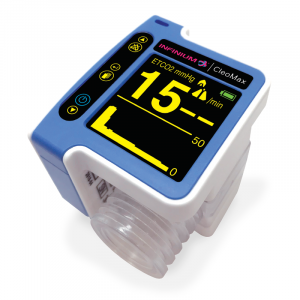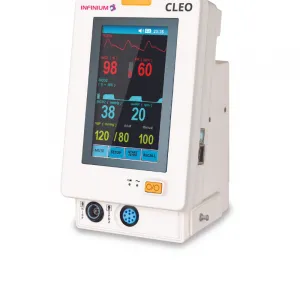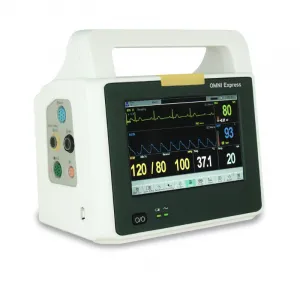The appearance of an EtCO2 monitor at dental offices nowadays is becoming increasingly common as dentists recognize the many important links between oral health and general wellness. At one time, a dentist would only ask questions pertaining to their patient’s oral health, such as how many times each day they floss and whether or not they drink coffee. Now, dental patients are getting their pulse, respiration, blood pressure, and temperature checked, too. Research is showing that individuals who forgo their oral health are likely to be just as lax about other aspects of their bodily health. What’s more, there are links between oral health complications and problems such as coronary infections and heart disease. Some issues can even be early indicators of more serious problems, with periodontal disease often preceding diabetes, for example.
The requirement of EtCO2 monitors in sedation dentistry makes it easier for dental professionals to monitor their patients’ health on a deeper level than simply flossing and coffee intake. In this article, we will go over what an EtCO2 monitor is, why they are required for sedation dentistry and the dangers of sedation without a monitor.
What is an EtCO2 Monitor?
An EtCO2 monitor is a machine that uses sensors to measure the levels of carbon dioxide (CO2) in a patient’s exhaled breath. CO2 is produced when the body breaks down food for energy and is expelled when we exhale. The level of CO2 in our blood is an indicator of how well our bodies are functioning.
Normal CO2 levels in the blood are between 35 and 45 mmHg. If the level of CO2 in a patient’s exhaled breath is lower than this, it could be an indication that they are not getting enough oxygen. Conversely, if the level of CO2 in a patient’s exhaled breath is higher than normal, it could be an indication that they are retaining too much carbon dioxide.
EtCO2 monitors can help dentists to identify when a patient’s CO2 levels are outside of the normal range so that they can take corrective action if necessary.
Why are EtCO2 Monitors Required for Sedation Dentistry?
EtCO2 monitors are required for sedation dentistry because they help to ensure the safety of sedated patients. As we mentioned earlier, CO2 levels in the blood can be an indicator of how well our bodies are functioning. This is especially true when it comes to the levels of oxygen and carbon dioxide in the blood.
If a sedated patient’s CO2 levels are too low, it could be an indication that they are not getting enough oxygen. This can lead to hypoxemia, which is a condition characterized by low oxygen levels in the blood. Hypoxemia can have serious consequences, such as brain damage, heart arrhythmias, and even death.
If a sedated patient’s CO2 levels are too high, it could be an indication that they are retaining too much carbon dioxide. This can lead to hypercapnia, which is a condition characterized by high carbon dioxide levels in the blood. Hypercapnia can also have serious consequences, such as brain damage, heart arrhythmias, and even death.
EtCO2 monitors help dentists to keep track of their sedated patient’s CO2 levels so that they can take corrective action if necessary. This helps to ensure the safety of sedated patients and minimizes the risk of serious complications.
The Standard Care for Anyone Under Sedation
The American Dental Association (ADA) and the Accessible Dental Service (ADS) both recommend the use of EtCO2 monitors for anyone receiving moderate or deep sedation. EtCO2 monitoring is considered the standard of care for these patients because it can help to prevent and/or identify critical problems such as hypoxemia (low blood oxygen levels), hypercapnia (high blood carbon dioxide levels), and aspiration.
A dentist who invests in a vital signs monitor often can help his or her patients get a glimpse of their overall health picture before their general practitioner, especially as many people will see their dentist twice a year while they make only one annual stop by their doctor’s office. A dentist or hygienist can easily take basic patient data with a vital signs monitor.
Normal range vital signs parameter values:
- Temperature – A body temperate at or right around 98.6 degrees Fahrenheit is considered normal.
- Pulse – For an adult, a pulse of between 60 and 100 beats per minute is normal; children’s pulses will normally range from 70 to 120 beats per minute.
- Respiration – The typical adult will take 12 to 20 breaths per minute when breathing at a normal rate.
- Blood pressure – Desirable blood pressure rates for an adult male are between 100 and 140 systolic and 60 to 90 diastolic. Females should register around 90 to 130 systolic and 50 and 80 diastolic
The Dangers of Sedation Without Monitoring
Sedation without a vital signs monitor can pose serious risks to patients. As we mentioned earlier, CO2 levels in the blood can be an indicator of how well our bodies are functioning. This is especially true when it comes to the levels of oxygen and carbon dioxide in the blood.
If a sedated patient’s CO2 levels are too low, it might signal that they aren’t receiving enough air. Hypoxemia is an illness characterized by decreased oxygen in the blood. Brain damage, heart arrhythmias, and even death can occur as a result of hypoxemia.
When a sedated patient has high CO2 levels, it could mean they are retaining too much carbon dioxide. If this is not corrected, it could lead to hypercapnia–a condition caused by elevated blood carbon dioxide levels. Hypercapnia can cause brain damage, heart arrhythmias, and death.
EtCO2 monitors enable dentists to see their sedated patient’s CO2 levels, so they can take action if the levels become too high or too low. This helps keep sedated patients safe and decreases the likelihood of serious complications.
Invest in an EtCO2 Monitor For Your Dental Office
A dentist who invests in a vital signs monitor often can help his or her patients get a glimpse of their overall health picture before their general practitioner, especially as many people will see their dentist twice a year while they make only one annual stop by their doctor’s office. A dentist or hygienist can easily take basic patient data with a vital signs monitor.




